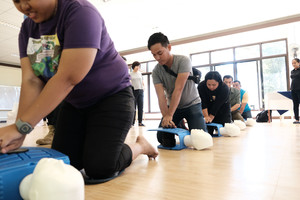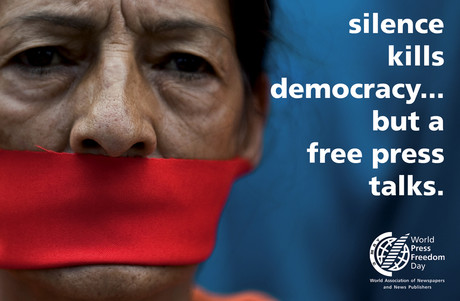By Andrew Heslop
The commitment to reporting Mindanao’s many stories is resolute, yet the message coming loud and clear after four days of safety training is that journalists will be doing things a lot more safely.
Twenty senior journalists, editors and publishers from a broad selection of Mindanao media organisations, along with some of their freelance colleagues, gathered in the forested hills outside of Davao City to complete an intensive safety course that delivered skills and knowledge to working professionals.
Organised by WAN-IFRA and the ACOS Alliance, and designed to instil safer working practices in a region underserved by professional training and support for media, the course welcomed established journalists, many of whom are highly experienced in covering dangerous assignments, despite – self-admittedly – being unprepared for many of the dangers they’ve already had to face.
“The whole curriculum of the training speaks to our daily lives as Mindanao journalists,” says Editha Caduaya, publisher of Newsline.ph in Davao City, and chair of the WAN-IFRA Mindanao Media Freedom Committee. “It’s sad, but until now we’ve been care-free about our security. But after this training, we’re equipped to provide safer coverage and will leave here better prepared to face the reality of the world we’re working in. The basic how-to’s will no longer be compromised.”
Mindanao came to international attention following the 2009 Maguindanao massacre, in which 58 people were killed during local political campaigning near the town of Ampatuan in south-central Maguindanao province. Thirty-four journalists were among those who died – the single most deadly attack on journalists anywhere in the world.
But Mindanao, rich in natural resources including gold, silver and uranium has long been the setting for rival political and economic factions, criminal groups, insurgents and – most recently – ISIS and its affiliates. As the saying goes here, “nobody fights over barren ground,” and Mindanao journalists are long-used to balancing the largely Manila-centric national media’s appetite for coverage of the latest armed conflict with a perception that, otherwise, the region is largely overlooked.
“I’ve spent a lot of time covering conflicts in places such as Marawi [in 2017, the location of a five-month battle between the Armed Forces of the Philippines and ISIS-affiliated militants, including the Maute and Abu Sayyaf Salafi jihadist groups],” says Bobby Lagsa, a freelancer from Cagayan de Oro City. “My experience with reporting peace building efforts, social justice and human rights abuses - I don’t want to glamorise it, but it’s very dangerous. But I need all the help I can receive to get the story out – it’s my duty as a journalist.”
Lagsa reported from Marawi during the 2017 siege, and was embedded with troops on the frontlines. “Training such as this is very much needed right now – especially in times of extremism. You could very quickly be faced with a mob, a spontaneous demonstration or insurgent group, and operating in these times means safety training becomes vitally important.
“It refreshes my memory on safety, but I’ve also gained new experiences such as how to do river crossings safely, applying basic first aid in the field, and it has opened my mind to the possibilities,” Lagsa continues. “I operate mostly alone, so updating my colleagues back home is very important. There are inherent dangers and listening to the experiences of colleagues just makes you better prepared.”
Mirasol Monteza, a reporter for RMN in Zamboanga City, agrees.“It’s a great help for us and a rare opportunity for journalists from Mindanao, we’re in a very remote corner of the world,” she says. “During the Zamboanga siege I was totally lost – I had no safety training before being sent to an active conflict area. I put my life at risk. After this training, if I’m sent to cover another conflict, I’ll know what to do.”
The exchange of knowledge has been crucial given that virtually everyone present has a story – or three – to tell, each one recounted as casually as if reporting from the local beat. They’re stories and experiences that most journalists will never come near to in their entire careers; here, they’re met with acknowledging nods and the occasional wry smile. It’s just another part of the job.
The training, delivered by Australia-based Key Objectives and funded, in part, through resources provided to the ACOS alliance by Reuters, was designed to ensure that a culture of safety becomes just as common. It dealt with issues Mindanao journalists regularly encounter and provided everyone with a common base level upon which to build as they move through their careers.
The dangers discussed – kidnappings, crime, conflict, natural disasters, etc. – are by no means new to these journalists, but the skills to handle them in a professional, safe way, most certainly are.
“If I don’t learn this stuff, I’ll very possibly die if I were to continue doing coverage the way I was before,” says Monteza. “The man-made threats are just too dangerous.”
Grace Vergara Tanghal, station manager with NDBC in Davao City, emphasised the time spent on preparation during the course to ensure safety in any eventuality.
“We create our own destiny, that really struck me – everyone’s safety and security depends on the kind of preparation we make before setting off on assignment,” says Vergara Tanghal. “The last few days have given me a wider understanding of the dangers we face in this kind of job. We were not at all equipped on awareness, preparation and actions to take before getting into a volatile situation.”
The centralised administrative system that, for generations, has dismissed the island as a lawless, provincial backwater may well be reconsidering its impressions of Mindanao, particularly as a result of President Rodrigo Duterte’s often-controversial approach to law and order at the national level. The long-term former mayor of Davao City has brought his hard-hitting approach to central government in an effort to tackle the Philippines’ chronic challenges.
While the effects of this are yet to drastically improve the general security situation, the training has responded to the wider facts of life in the Philippines.
“It’s not just something to apply in my role as a journalist,” says Vergara Tanghal. “I’ll be telling my children, my family, how to deal with dangerous situations. Like just getting in the car and going for a trip – it’s very basic. But it’s a big help for facing life here as well as our assignments and day-to-day professional activity.”
A few days is too short a time to instil the journalists present with everything they’ll need to respond to the challenges they may face – repetition and practice of the skills acquired are vital to maintaining and increasing confidence in how to react in pressure situations. As is follow-up and sharing of the knowledge gained amongst a wider pool of media professionals, and this is the plan for many of the participants.
“I’ll be passing this knowledge on to colleagues back in Zamboanga City,” says Monteza. “The first-aid skills, safety measures, what I experienced. It’ll be of big benefit to my colleagues and friends, their families, so they know what to do if they face calamities or attacks. I hope that within my company and via the Zamboanga Press Club, we’ll be able to organise similar training for our colleagues.”
“I’ll definitely take this back to my staff, and somehow impart to them what I’ve learned here,” agrees Vergara Tanghal. “It’s just so important.”
The Mindanao safety training took place under WAN-IFRA’s Strengthening Media and Society programme, a two-and-a-half-year initiative supported by the Ministry of Foreign Affairs of Denmark. The Mindanao Media Freedom Committee, one of three Committees established in the Philippines, is a strategic element in the delivery of this programme, guiding and informing WAN-IFRA’s advocacy work in each country of intervention.
More details can be found at www.wan-ifra.org/pressfreedom.
The ACOS Alliance works to embed a culture of safety across newsrooms and among freelance and local journalists worldwide. The Alliance is an unprecedented coalition of news organisations, freelance journalist associations and press freedom NGOs working together to champion safe and responsible journalistic practices. Established in 2015, the ACOS Alliance has grown into a unique strategic alliance committed to finding and implementing practical and effective initiatives that enable newsrooms and freelancers to access the resources they need to meet basic safety standards outlined in the ACOS Principles. As an Alliance, ACOS facilitates a space for stakeholders to enter a closer dialogue, create productive partnerships, find collaborative ways to improve the safety of local journalists and freelancers, and extend the impact of their work.




